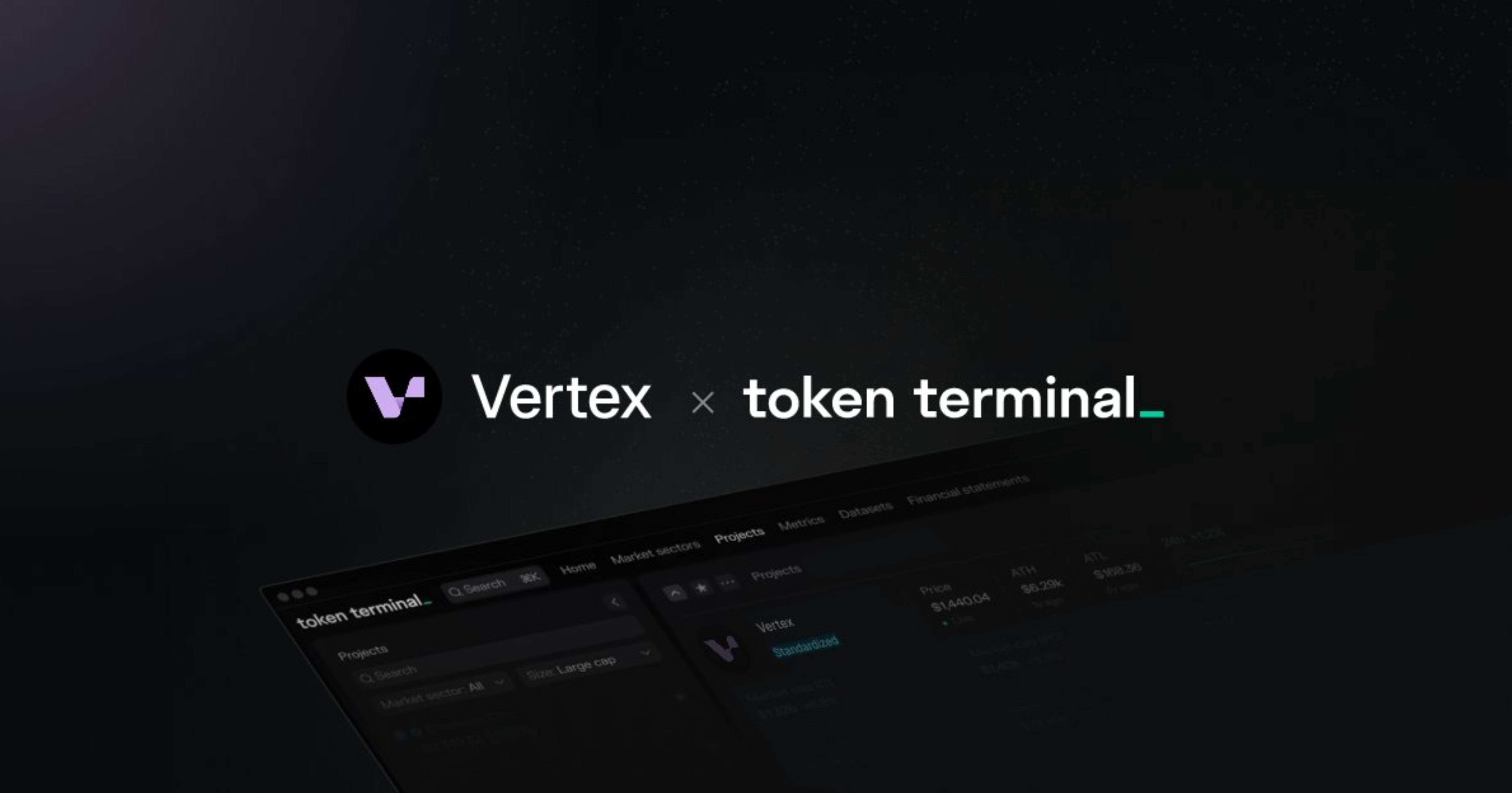News
To ensure accurate and ongoing stakeholder reporting, Vertex entered into a Data Partnership with Token Terminal.

Executive summary
Vertex Protocol is one of the fastest growing derivative exchange projects on Sei, with deployments also on Arbitrum, Base, Blast, and Mantle. The project has raised an $8.5m seed round from crypto-native funds, and its core contributors are a team of seasoned traders and engineers spanning both TradFi and DeFi markets. Now, with ~$80m in net deposits, Vertex recognized the need for reliable, continuous, and data-driven stakeholder reporting.
To improve its existing onchain analytics and stakeholder reporting, Vertex turned to Token Terminal, a leading onchain data platform trusted by institutional partners like Bloomberg. Token Terminal's dedicated focus on data standardisation made it an ideal partner for Vertex. The decision to partner was further eased by the fact that Token Terminal already had a public track record of reporting standardised financial and usage metrics for other leading derivative exchange projects, such as GMX, dYdX, Holdstation, and more.
“By partnering with Token Terminal, we’re able to benchmark our performance against the competition in a fair and accurate way. Having a real-time dashboard on Token Terminal is not only a great tool for our team, but for all Vertex stakeholders.”
Darius Tabai, Founding Contributor to Vertex
Data Partnership
To ensure accurate and ongoing stakeholder reporting, Vertex entered into a Data Partnership with Token Terminal.
The Data Partnership consists of four different parts:
1. Smart contract registry
Since Vertex isn’t an appchain, but a set of smart contracts running on multiple chains, this first step did not require a node infrastructure setup. Instead, Token Terminal was able to rely on its existing node infrastructure.
To start, the Vertex and Token Terminal teams worked together to build a labelled registry of Vertex’s smart contracts across chains.
A complete smart contract registry is a prerequisite for the next step: the transformation of raw blockchain data into standardised financial and usage metrics.
2. Metric transformations
Leveraging the information in the smart contract registry, Token Terminal’s research team transformed the raw blockchain data from the smart contracts into standardised financial and usage metrics.
For a derivative exchange project project like Vertex, the standardised metrics include net deposits, notional trading volume, fees, revenue, daily active users, and more.
3. Discovery and reporting
After the metric transformations, Vertex was listed on the derivative exchanges market sector dashboard on Token Terminal, and also featured on the recently launched Discover page. As a result, users, developers, and investors can now refer to a single source when deciding which protocols to use, integrate with, and/or invest in.
For Vertex, the dashboards on Token Terminal streamline the reporting to existing and future stakeholders.
4. Data maintenance
Standardised onchain metrics require ongoing maintenance work, especially when the goal is completeness and accuracy.
The maintenance work has only grown in magnitude and importance over the last few years, as more DeFi projects have evolved from single to multichain apps, with often more than one business line.
A Data Partnership with Token Terminal means that Vertex can rely on Token Terminal to manage all future updates to its metrics, and instead direct all focus on growing its onchain business.
Future opportunities
In addition to standardised financial and usage metrics, Vertex and Token Terminal are excited to explore opportunities to create custom dashboards with more project-specific metrics. These dashboards would offer both LPs and traders deeper insight into the platform’s features and performance. Some examples include LP profitability, trading activity by trader profile, and more.
Through its partnership with Token Terminal, Vertex turns transparency into a competitive advantage and continues to build trust with its growing community.
The authors of this content, or members, affiliates, or stakeholders of Token Terminal may be participating or are invested in protocols or tokens mentioned herein. The foregoing statement acts as a disclosure of potential conflicts of interest and is not a recommendation to purchase or invest in any token or participate in any protocol. Token Terminal does not recommend any particular course of action in relation to any token or protocol. The content herein is meant purely for educational and informational purposes only, and should not be relied upon as financial, investment, legal, tax or any other professional or other advice. None of the content and information herein is presented to induce or to attempt to induce any reader or other person to buy, sell or hold any token or participate in any protocol or enter into, or offer to enter into, any agreement for or with a view to buying or selling any token or participating in any protocol. Statements made herein (including statements of opinion, if any) are wholly generic and not tailored to take into account the personal needs and unique circumstances of any reader or any other person. Readers are strongly urged to exercise caution and have regard to their own personal needs and circumstances before making any decision to buy or sell any token or participate in any protocol. Observations and views expressed herein may be changed by Token Terminal at any time without notice. Token Terminal accepts no liability whatsoever for any losses or liabilities arising from the use of or reliance on any of this content.
Stay in the loop
Join our mailing list to get the latest insights!
Continue reading

Customer stories: Token Terminal’s Data Partnership with Linea
Through its partnership with Token Terminal, Linea turns transparency into a competitive advantage and continues to build trust with its growing community.

Introducing Tokenized Assets
Token Terminal is expanding its standardized onchain analytics to cover the rapidly growing category of tokenized real-world assets (RWAs) – starting with stablecoins, tokenized funds, and tokenized stocks.

Customer stories: Token Terminal’s Data Partnership with EigenCloud
Through its partnership with Token Terminal, EigenCloud turns transparency into a competitive advantage and continues to build trust with its growing community.